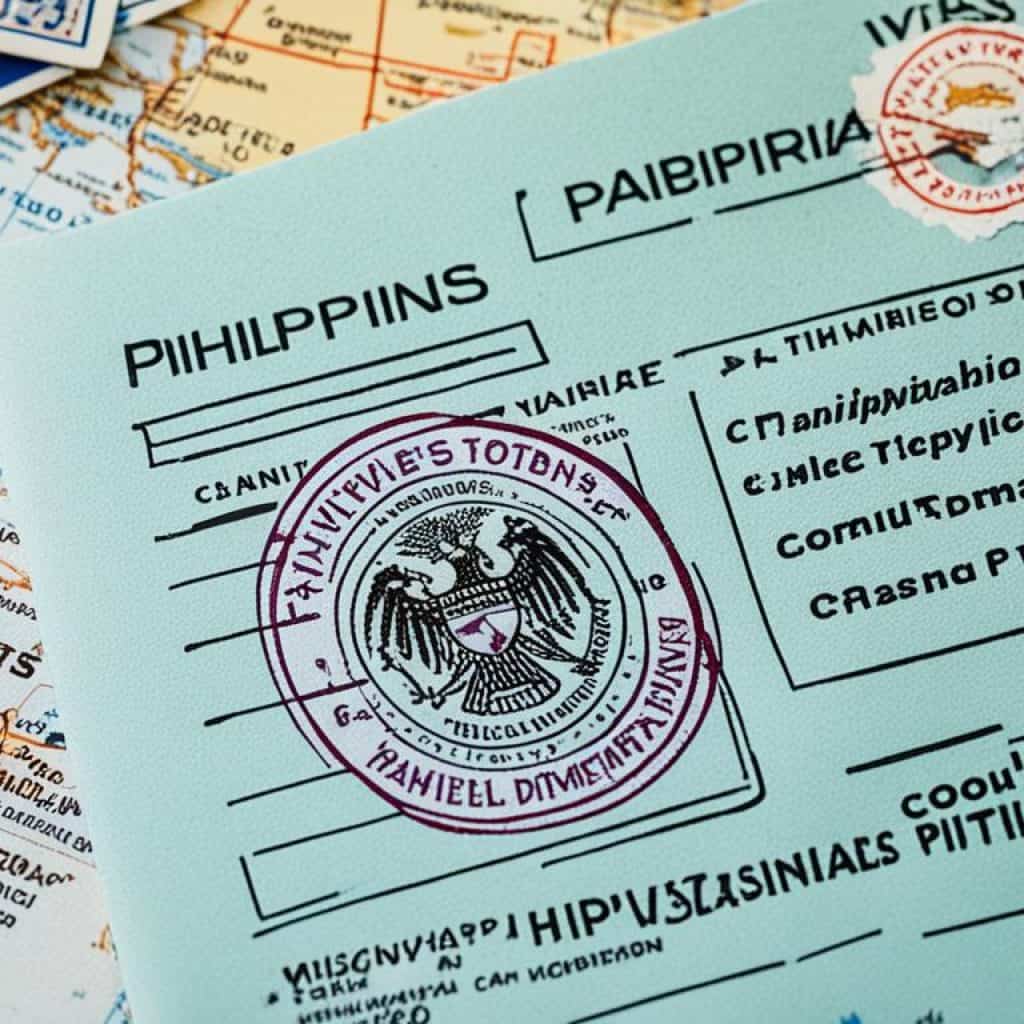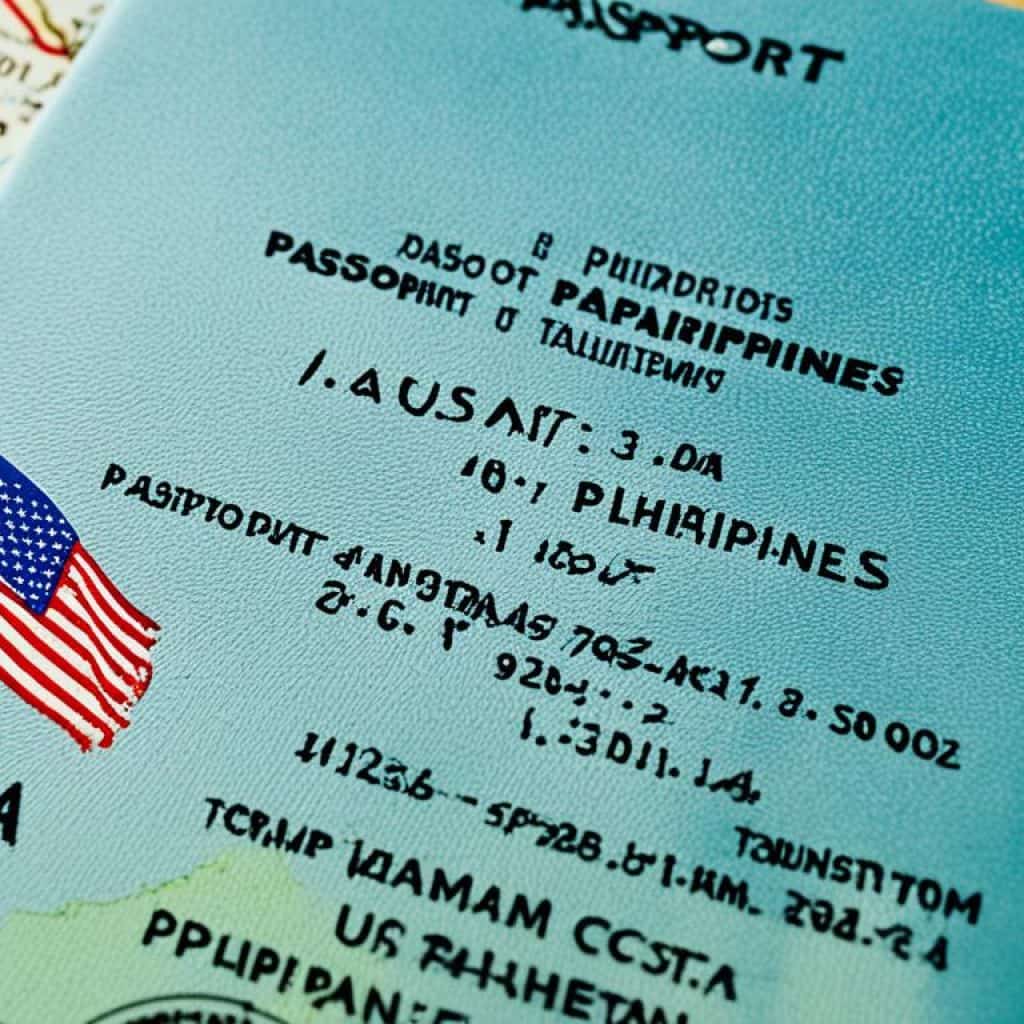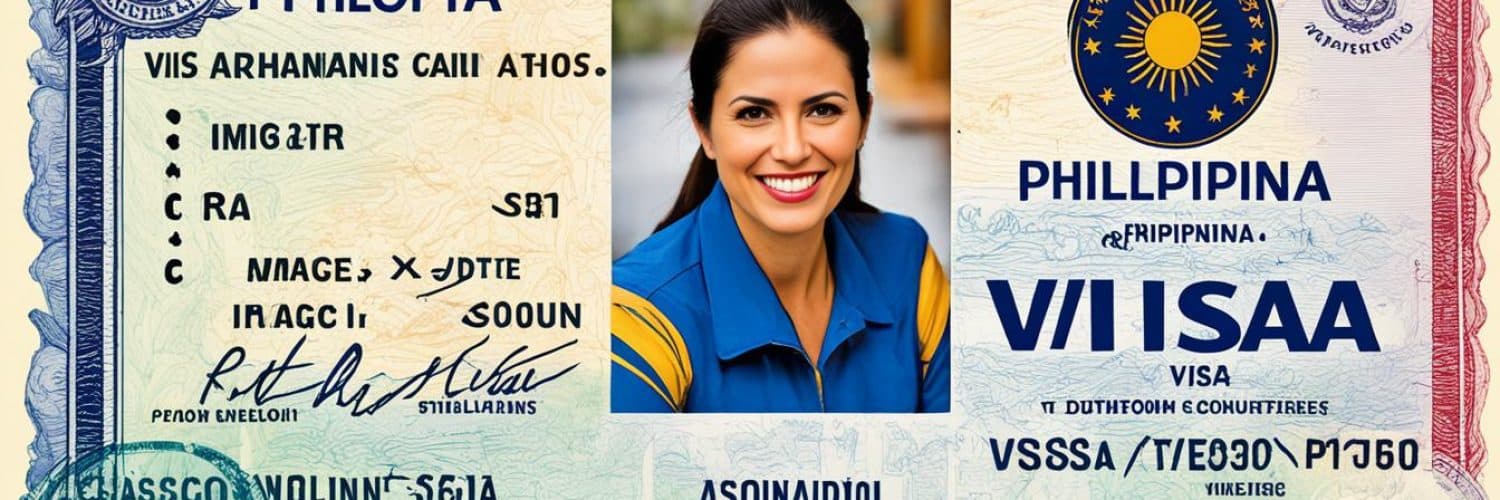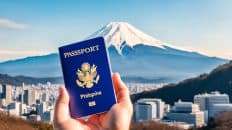Are you a U.S. citizen planning a trip to the Philippines? You’ll need to understand the visa requirements. It can be tricky to figure out what you need for a smooth trip. Here’s what you should know before you leave.
Key Takeaways:
- U.S. citizens can enjoy visa-free entry to the Philippines for up to 30 days.
- Visa extension is possible for those who wish to stay longer.
- Applying for a visa requires submitting necessary documents and paying the appropriate fees.
- It is essential to be aware of the restrictions and limitations of the visa-free privilege.
- U.S. citizens can seek assistance from the U.S. Embassy in case of emergencies or concerns during their stay.
Visa Policy for Philippines
The Philippines has a visa policy aimed at travelers from different countries. For those holding a United States passport, there is great news. You can visit the Philippines without getting a visa first. This visa-free privilege has some rules and limits you need to know.
American citizens can stay in the Philippines for a maximum of 30 days under this policy. This stay lets them enjoy everything from stunning beaches to lively cities. It’s a fantastic chance to dive into the Filipino culture and hospitality.
“The Philippines welcomes U.S. citizens to experience its tropical paradise without the hassle of a visa. From the magnificent rice terraces in Banaue to the stunning underwater world of Palawan, there is so much to discover and enjoy in this captivating archipelago.”
To use the visa-free privilege, Americans must meet certain conditions. They need a valid passport with a minimum of six months validity beyond their planned stay. A confirmed return ticket to the United States or the next destination is also needed.
To avoid problems when arriving, make sure your passport is up to date. It should cover your whole stay. Plus, a confirmed return ticket shows immigration you plan to leave on time.
Knowing the visa policy helps U.S. citizens plan their Philippines trip well. They can enjoy pristine beaches, delicious food, and lively culture without worry. The Philippines is full of great experiences for all travelers.
We will explore more about the visa-free privilege for U.S. citizens in the next section. This includes the application process and other key points.
Visa-Free Privilege for U.S. Citizens
Planning a trip to the Philippines? Good news for U.S. citizens! You won’t need a visa for short visits up to 30 days. This makes it easy to see the Philippines’ beautiful islands and vibrant cities. Enjoy the culture, local foods, and breathtaking landscapes without the visa hassle.
To enjoy this visa-free entry, make sure your passport is valid for six months after your trip. Also, have your return ticket ready. This proves you plan to leave on time. It’s all part of smooth travel prep.
Remember, this visa-free deal is for tourism only. Want to work or stay longer than 30 days? You’ll need to apply for a proper visa or extension. This way, U.S. citizens can have a worry-free and memorable visit. Enjoy the beaches, historical spots, and make lasting memories in the Philippines.
Key Points:
- U.S. citizens have visa-free entry to the Philippines for up to 30 days.
- A valid passport with a minimum validity of six months beyond the intended stay is required.
- A confirmed return ticket to the United States or the next destination is necessary.
- Visa-free entry is for tourism purposes only.
Visa Extension
If you’re a U.S. citizen planning to stay longer in the Philippines, you can apply for a visa extension. This can be done at the Bureau of Immigration. It lets you enjoy the country for up to 59 days from your arrival date.
It’s key to not overstay your initial 30 days without a visa. This can lead to fines. Make sure to apply for your extension before your visa-free time ends.
When you apply, you’ll need a few things. These include your valid passport and proof of finances. Also, fill out the visa extension form carefully.
Steps to Apply for a Visa Extension:
- Visit the nearest Bureau of Immigration office in the Philippines.
- Procure a visa extension form and fill it out accurately.
- Prepare the necessary documents, including your passport and proof of financial means.
- Submit your application with the completed form and supporting documents.
- Pay the visa extension fee.
- Wait for the processing of your application.
- Once approved, you will receive your extended stay period.
“Applying for a visa extension lets you stay longer in the Philippines. Remember to follow the steps and guidelines to avoid issues.”
To have a smooth visa extension process, apply before your current visa ends. This ensures you have enough time for processing. Remember, the time it takes can vary.
By doing everything correctly, you can extend your stay. Enjoy more of the Philippines’ incredible culture, nature, and hospitality.
Visa Application Process
Are you a U.S. citizen planning to visit the Philippines and need a visa? Understanding the application process is crucial. By following the right steps and having the necessary documents, your visa application will go smoothly.
To start, visit the nearest Philippine Embassy or Consulate. They will give you the needed forms and help with the process. It’s a good idea to schedule an appointment early to avoid waiting.
For a Philippines visa, collect these documents:
- A filled-out visa form from the embassy’s site or in person.
- Your passport, with at least six months left before it expires.
- Passport-sized photos that meet the set requirements.
- Details of your trip, like a ticket or a travel plan.
- Financial proof showing you can afford your stay, like bank statements or job details.
Apply for your visa well before your trip, since processing times vary. Depending on the embassy, it could take from a few days to weeks. Starting early means getting your visa in time for your departure.

Remember, each embassy or consulate has its unique rules and processes. Always check their official site or contact them for the latest information.
After your application is approved, your visa will be stamped in your passport. Check your visa’s details, like its valid period and conditions, before heading to the Philippines.
Knowing the visa application process, you’re set for your Philippine adventure. With all your documents ready and submitted on time, your travel will be worry-free.
Visa Types
The Philippines has many visa types for different travel needs. This ensures that U.S. citizens can pick the right visa. Whether it’s for vacation, work, or studying, knowing your visa options is key.
Here are some main visa types for U.S. citizens:
- Tourist Visa: Perfect for leisure trips, it lets you see the Philippines’ beauty, history, and culture. Check how long it lasts and what you need for it.
- Business Visa: This is for U.S. citizens planning business trips, like meetings or conferences. It helps you do business in the Philippines.
- Student Visa: If you’re going to study in the Philippines, you need this visa. It’s for university or training center enrollment. You must show you’re accepted by an authorized place.
- Work Visa: For work in the Philippines, U.S. citizens need this visa. It lets you legally work and get paid. Bring a job offer and contract.
These visa types are just some options for visiting the Philippines. Each has its own rules and needs. So, make sure to get the right documents and meet all criteria.
Note: You can get more info about each visa from the nearest Philippine Embassy or Consulate in the U.S.
Visa Types for Specific Purposes
Besides the common visas, there are special ones for certain needs, like:
Retirement Visa: This visa is for retirees wanting to live in the Philippines. It’s a way to enjoy retirement in a beautiful setting.
Special Investor’s Resident Visa: For those investing in the Philippines, this visa offers benefits. It encourages U.S. citizens to help the economy and enjoy living there.
These special visas have their own requirements. If interested, talk to the nearest Philippine Embassy or Consulate for guidance.
Picking the right visa for your Philippine trip is crucial. Make sure to check all requirements. This ensures a smooth visa application process.
Visa Fees
When planning a trip to the Philippines, U.S. citizens should know the visa fees. These fees vary by visa type and stay length. It’s key to look up current fees before applying.
To avoid surprises, understand the fees early on. This will make the visa process go smoothly.
Here are the visa application fees for U.S. citizens going to the Philippines:
| Visa Type | Fee |
|---|---|
| Tourist Visa (Single Entry) | $30 |
| Tourist Visa (Multiple Entries) | $60 |
| Business Visa (Single Entry) | $40 |
| Business Visa (Multiple Entries) | $90 |
| Student Visa | $50 |
| Employment Visa | $100 |
Note that the fees mentioned can change. Always check with the Philippine Embassy or Consulate before applying. Paying the right fee is key to a smooth application.
Also, get the Visa Fee Official Receipt after paying. It’s needed when you apply. The fee is non-refundable, no matter the application’s outcome.
Knowing about the fees and paying correctly helps U.S. citizens apply confidently. This lets them enjoy their Philippines trip more.
Visa Processing Time
The time it takes to process a U.S. citizen’s visa for the Philippines can change. It depends on how many applications the Philippine Embassy or Consulate gets and the details of each case. To make sure your visa application goes smoothly and quickly, apply well before your trip.
Applying early helps avoid delays or problems. Remember, the time needed for visa processing can be different for each person. For the latest information, always check with the authorities.
In some situations, you can pay extra for faster processing. This is great for those who need their visa quickly. But, not all applications can be sped up. Make sure to ask the Philippine Embassy or Consulate about this possibility.
To have a good experience getting your visa, plan ahead. Give yourself enough time for the process and keep up with any new information or changes.
Visa Processing Time
| Visa Type | Processing Time |
|---|---|
| Tourist Visa | Approximately 10-15 business days |
| Business Visa | Approximately 10-15 business days |
| Student Visa | Approximately 15-20 business days |
The times listed in the table are just estimates. They can change based on each visa’s details. For the most precise and recent processing times, talk to the Philippine Embassy or Consulate.
Visa Restrictions and Limitations
U.S. citizens can travel to the Philippines without a visa for a short time. But, this only covers tourism. It is not for work or business. Those wanting to work or do business must get the right visa.
Not following these rules can lead to big problems. You could face fines, be sent home, or have trouble coming back. So, it’s crucial to know and follow the visa rules from the Philippines.
Want to work there? You’ll need to get a work visa first. You might have to show a job contract or a letter from your employer.
Business Activities
Planning on doing business? You need the right visa for that too. The Philippines offers different visas for business. One example is the 9(a) Temporary Visitor Visa for Business.
Each business visa has its own rules. These depend on your business type and how long you plan to stay. Talk to the Philippine Embassy or Consulate to understand what you need.
Following visa rules for work or business keeps your stay in the Philippines smooth and legal. So, always make sure to get the right visa.
Security and Safety Information
When you plan to visit the Philippines, it’s vital to know about the safety and security there. The country is known for its beauty and welcoming people. However, staying informed and careful ensures a safe journey.
Be aware of the risk of terrorism and crime in the Philippines. Look out for scams, pickpocketing, and petty theft. Always keep your valuables safe, especially in busy places like tourist spots and on public transport.
“Travelers should be cautious of scams, pickpocketing, and other petty crimes.”
Listen to the local authorities and keep up with travel advisories. Stay informed about the security situation by checking news and official updates from the U.S. Department of State.
It’s wise to register with the U.S. Embassy when you arrive in the Philippines. This helps them assist you quickly if any problems occur. They can help with medical issues, reporting crimes, and more.
With the right precautions and knowledge, your visit to the Philippines can be both safe and wonderful.

Assistance for U.S. Citizens
U.S. citizens visiting the Philippines can trust in the support of the U.S. Embassy during emergencies. The embassy offers a variety of services to keep travelers safe and secure.
Here’s how the U.S. Embassy can help:
- Medical Care: The U.S. Embassy offers details on local health facilities. They help with medical evacuations and advice on insurance.
- Reporting Crimes: Victims of crimes can get embassy help to contact local police. They also guide you through legal steps.
- Contacting Relatives or Friends: The embassy aids in reaching out to your loved ones. They ensure you can communicate when needed.
- Legal Advice: Need legal help in the Philippines? The embassy provides information on local legal services and connects you with lawyers.
- Repatriation Assistance: During tough times, like natural disasters, the embassy assists U.S. citizens to return safely to the U.S.
The U.S. Embassy in the Philippines works hard to protect U.S. citizens. They offer help with medical, legal, or crime-related issues. Always keep the embassy’s contact info handy and reach out in emergencies.
Important Contact Information:
| U.S. Embassy in the Philippines | Address | Contact Number | |
|---|---|---|---|
| U.S. Embassy Manila | 1201 Roxas Boulevard, 1000 Manila, Philippines | +63-2-5301-2000 | co*************@***te.gov |
Travel Tips for U.S. Citizens
Planning a trip to the Philippines from the U.S.? Make sure you’re prepared. Here are some travel tips for a safe and fun journey:
1. Register with the Philippines Embassy
Before your trip, sign up with the U.S. Embassy in the Philippines. This keeps you safe in emergencies. It makes sure you’re updated during your stay.
2. Follow Local Laws and Regulations
Learn about the Philippines’ laws and customs. Respect the country’s traditions and rules. This helps make your trip smooth and trouble-free.
3. Avoid Displaying Signs of Wealth
Don’t show off expensive things like jewelry or gadgets. This can attract thieves. Stay low-key to avoid risks.
4. Use Reliable Transportation Services
Choose trustworthy transport in the Philippines. Go for well-known taxis or ride-sharing apps. Make sure the price is clear before you go.
5. Maintain Awareness of Surroundings
Be alert, especially in busy places. Be careful of pickpockets and avoid being out alone at night. Staying careful keeps you safe.
In the spirit of adventure, always be safe and informed in the Philippines.
These tips ensure a great trip to the Philippines. Always put your safety first. Enjoy the beautiful culture and nature of the country.
Health and Safety Considerations
When you plan a trip to the Philippines, think about health and safety. This ensures a stress-free visit. Taking steps beforehand avoids issues during your stay.
Vaccinations and Travel Itinerary
Check if you need vaccines before going to the Philippines. Some areas have health risks. Vaccines protect against diseases.
It’s smart to talk to a healthcare pro or visit a travel clinic. They give you current vaccine advice.
Comprehensive Travel Insurance
Make sure you have good travel insurance for trips abroad, like to the Philippines. Pick insurance that covers medical evacuation. This way, you’re covered for medical emergencies and can get home if needed.
Travel insurance offers peace of mind and protects your wallet against surprises.
Food and Water Hygiene
Being careful with food and water keeps you healthy. Drink just bottled or purified water. Avoid tap water ice.
Eat at clean places. Wash your hands often, especially before eating, to lower illness risks.
“By being careful with health and safety, U.S. citizens can enjoy their Philippines trip without health worries.”
Putting health and safety first makes for a great Philippines trip. Get the right vaccines, insurance, and be wise with food and water. This leads to a smooth and fun experience.
Cultural and Etiquette Tips
Visiting the Philippines as a U.S. citizen is a chance to dive into local culture and customs. To make your visit respectful and enjoyable, get to know these cultural and etiquette tips:
Show Respect for Local Traditions
Respecting local traditions, religious beliefs, and social norms is key in the Philippines. Take time to learn about Filipino customs and practices. Show that you value their cultural heritage through what you do and say.
Dress Modestly
The Philippines generally has a relaxed dress code, but it’s good to dress modestly. This is especially true at religious sites or rural places. Avoid revealing or provocative outfits to respect local culture and traditions.
Remove Shoes before Entering
In many Filipino homes, removing your shoes before entering is common. This is also done in temples and religious sites. Watch what locals do and do the same to show respect and prevent offense.
“Respecting local culture and customs is key in the Philippines. By showing reverence and adapting to local practices, you create positive interactions and lasting memories.”
Show Courtesy and Politeness
Filipino culture values being polite and respectful to others. Greet people with a smile and use “po” or “opo” when speaking to elders. “Please” and “thank you” are important and will help make your visit pleasant and welcoming.
Embrace the Filipino Hospitality
The Filipino people are known for their kindness and hospitality. Embrace their welcoming nature and engage with locals whenever possible. This interaction gives you insight into their culture, traditions, and lifestyle.
Be Mindful of Social Etiquette
In the Philippines, practice ‘mano’ as a sign of respect to elders. It’s also polite to use utensils when dining with locals. Wait for the host to start meals.
By following these tips, U.S. citizens can have a culturally enriching visit to the Philippines.
Conclusion
Knowing what U.S. citizens need for a Philippines trip is key. By keeping up with the rules, you can have a smooth visit. Make sure to check travel tips and stay safe.
The Philippines has a lot to offer, from amazing beaches to rich culture and tasty food. U.S. citizens can stay for 30 days without a visa. If you want to stay longer, you can look into visa extensions.
Don’t forget to get the right visa if you need one. Be ready for the fees and how long it takes to process. Always have good travel insurance for peace of mind. With some planning, you can enjoy a stress-free time in the Philippines.


















Add comment